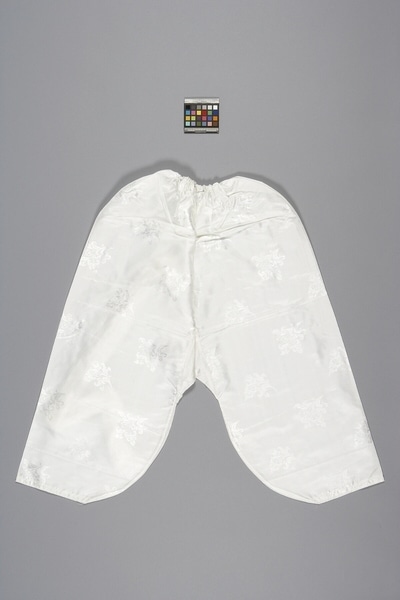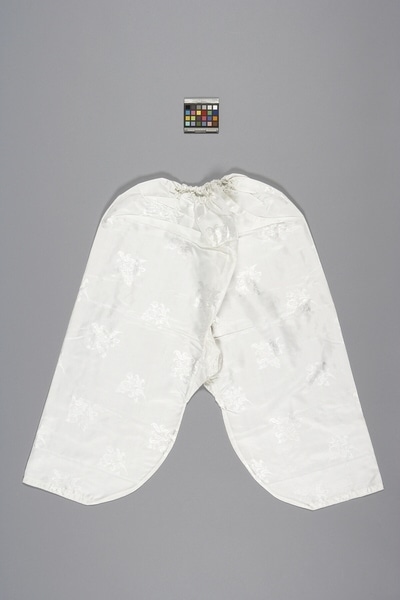Underwear Item Number: 376/4 from the MOA: University of British Columbia


Description
Underwear of shiny white rayon damask. The underwear has a two-piece gusset in the crotch and long pant legs. The pants have a curved inside seam that narrows to the ankle. At the ankle the pants are gathered on a cord of black elastic in a waist casing. All seams are finished by folding edges of fabric inside so that there are no raw edges. The inside is unlined. The damask is woven containing a floral motif.
History Of Use
During the 19th century, women’s underwear generally had a crotch slit that continued to the front, but this was later simplified during the modernization of Korea and the slit limited to the back. Later, shoulder straps were added. More elaborated underwear had additional flaps at the crotch to ensure that the skin was covered, which was very important during the Chosun Dynasty. Ordinary people wore more simple underwear, the construction of which was not elaborated. Only women’s and girl’s under-trousers had the slit; men’s did not. Men also did not wear as many layers of underwear as women did. Women wore the following layers of lower-body underwear: a loincloth that passed between the legs and fastened front and back to a waistband (“Da-ri-sok-got”); wide, straight-legged under-trousers with a side opening with ties and with flaps (“Sok-sok-got”); back- or side-opening under-trousers tapering to the ankles with a crotch-slit and with flaps at the opening (“Sok-ba-ji”); wide, straight-legged under-trousers with flaps (“Dan-sok-got”); under-skirt (“Sok-chima”); and outer skirt (“Chima”). Many layers of underwear were important to add bulk for elegance, and to protect their virginity. Underwear was tied below the wearer’s breasts, and extended to the back of her foot. Entertainers, “Gae-seng”, might intentionally show their ankles and the edges of their underwear. Underwear of this type, from 1970, is very much simplified, but retains the traditional rounded leg shape. It was worn for special occasions with traditional costume after the wars. It was worn by ordinary women, not those of higher social class. Underwear was and is boiled as part of the laundry process.
Specific Techniques
All sewing is done by machine.
Item History
- Made in Korea during 1970
- Collected during 1970
- Owned by Freda Abrahamson before April 10, 1977
- Received from Freda Abrahamson (Donor) on April 10, 1977
What
Who
- Culture
- Korean
- Previous Owner
- Freda Abrahamson
- Received from
- Freda Abrahamson (Donor)
Where
- Holding Institution
- MOA: University of British Columbia
- Made in
- Korea
When
- Creation Date
- during 1970
- Collection Date
- during 1970
- Ownership Date
- before April 10, 1977
- Acquisition Date
- on April 10, 1977
Other
- Item Classes
- textiles
- Condition
- good
- Accession Number
- 0376/0004